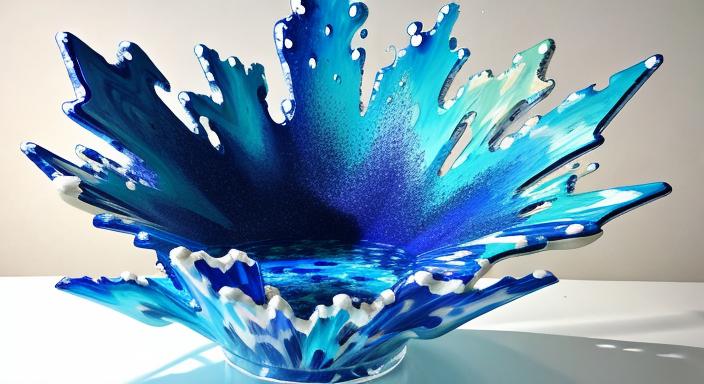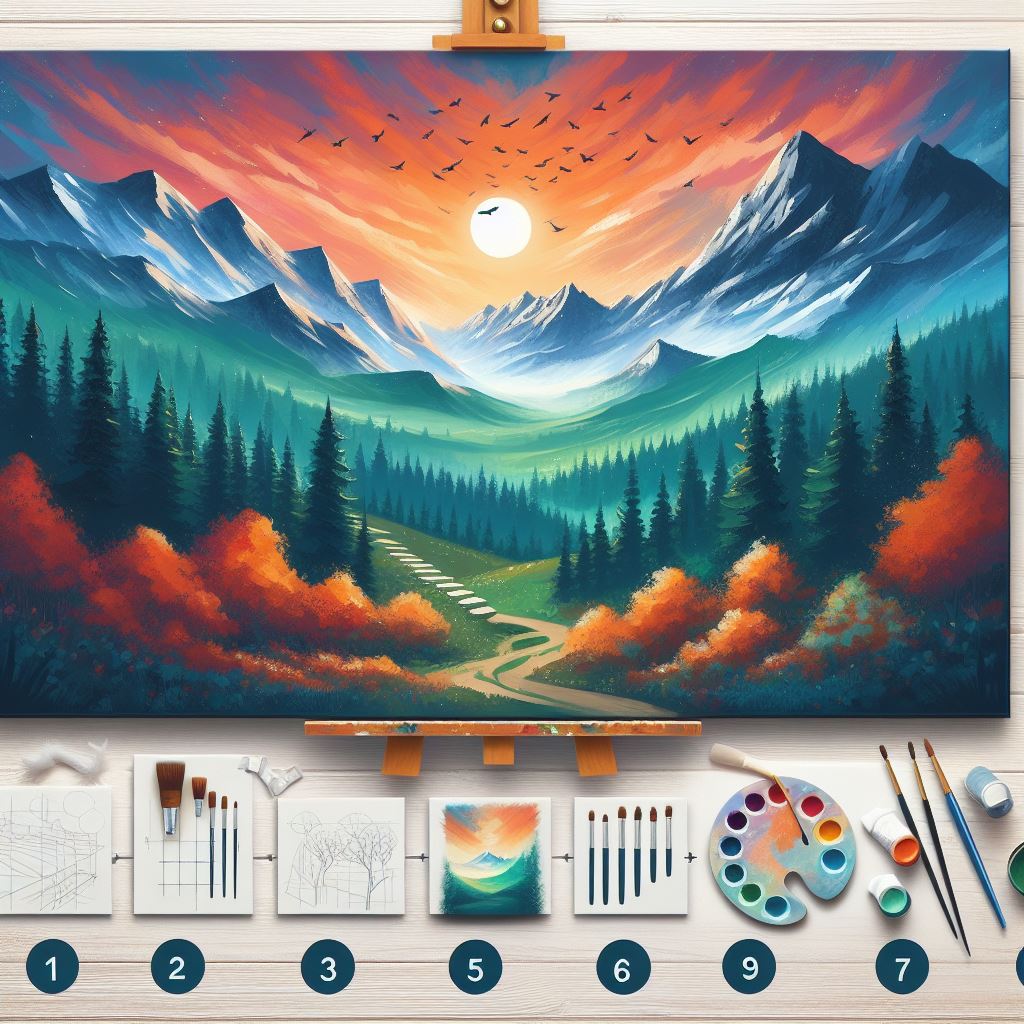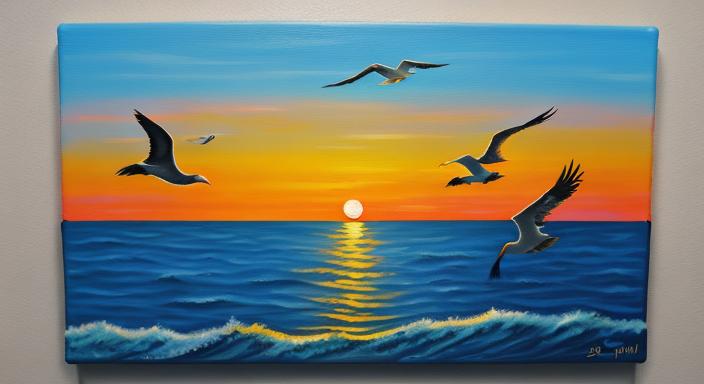
Acrylic painting is a versatile and popular art form that has captured the imagination of artists worldwide. With their vibrant colors, quick-drying properties, and wide range of techniques, acrylics offer endless possibilities for creativity and expression. In this article, we will explore acrylic painting ideas, techniques, and tips to inspire and guide artists of all skill levels.
Why Choose Acrylic Paints?
Acrylic paints have become a favorite medium among artists for several reasons:
- Versatility: Acrylics can be used on various surfaces, including canvas, paper, wood, and even metal.
- Quick-Drying: Unlike oil paints, acrylics dry quickly, allowing artists to work on multiple layers and sections of a painting without waiting for long periods.
- Vibrant Colors: Acrylic paints are known for their rich, vibrant colors, which can be mixed and blended to create a wide range of hues
- Durability: Once dry, acrylic paintings are resistant to fading and yellowing, making them a great choice for long-lasting artwork
- Beginner-Friendly: Acrylics are easy to work with, making them an excellent choice for beginners
In the following sections, we will delve deeper into acrylic painting techniques, ideas, and tips to help you unlock your creativity and create stunning acrylic paintings.
Getting Started with Acrylic Painting
Before diving into the world of acrylic painting, it’s essential to gather the necessary supplies and set up your workspace. Here’s what you’ll need:
Essential Supplies
- Acrylic paints in a variety of colors.
- Brushes in different sizes and shapes.
- Canvas or other painting surfaces.
- Palette for mixing paints.
- Water container for rinsing brushes.
- Paper towels or a cloth for blotting brushes.
- Optional: Painting mediums (e.g., retarder, flow improver) to adjust the consistency of your paints.
Setting Up Your Painting Space
- Choose a Well-Ventilated Area: Acrylic paints can emit fumes, so it’s essential to work in a well-ventilated area or use a fan to circulate air.
- Protect Surfaces: Cover your work surface with a disposable drop cloth or plastic sheeting to protect it from paint splatters.
- Set Up Your Workspace: Arrange your paints, brushes, palette, water container, and other supplies within easy reach.
Now that you have your supplies and workspace set up, you’re ready to start exploring acrylic painting ideas and techniques. In the next section, we’ll discuss easy acrylic painting ideas for beginners.
Easy Acrylic Painting Ideas for Beginners
Acrylic painting is a fantastic medium for beginners due to its versatility and quick-drying properties. There are numerous easy acrylic painting ideas to explore, and in this section, we will discuss some of the most popular ones.
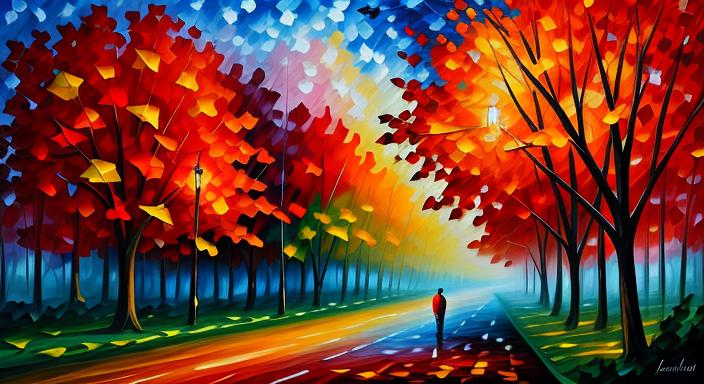
Landscape Painting
Landscape paintings can be a great starting point for beginners. They allow you to practice blending colors and creating depth. Some popular landscape painting ideas include:
- Simple Landscapes: Start with a basic scene, such as a mountain range or a beach, and gradually add details as you become more comfortable with the medium.
- Skies: Painting skies can be challenging, but with practice, you can create stunning sunsets, sunrises, and cloud formations.
- Trees and Foliage: Practicing painting trees and foliage can help you master the art of blending colors and creating texture.
Abstract Art
Abstract art is a great way to explore your creativity and experiment with different techniques. Some easy abstract acrylic painting ideas include:
- Smooth Blended Abstract Paintings: Squeeze different colors of paint directly onto the painting surface and blend them using a dry hard-bristle stencil brush.
- Dry Brush Technique: Use a clean brush with no water to apply a little bit of paint, creating a feathery or textured effect.
- Impasto: Use a stiff brush or palette knife to move around larger amounts of paint, creating texture.
Floral Artwork
Floral artwork is a popular choice for beginners. It allows you to practice blending colors and creating texture. Some easy floral painting ideas include:
- Water Lilies: Create a serene scene with water lilies floating on a calm pond.
- Roses: Practice painting the delicate petals and thorns of roses.
- Sunflowers: Capture the vibrant yellow hues and bold shapes of sunflowers.
Still Life Painting
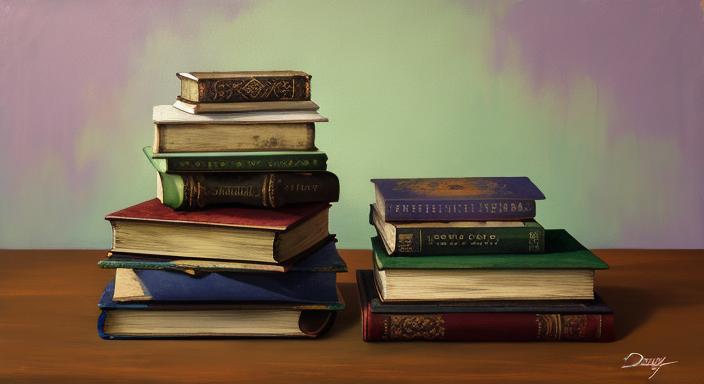
Still-life painting is another great way to explore acrylic painting. It allows you to practice painting objects in different lighting conditions and angles. Some easy still-life painting ideas include:
- Fruit: Paint a bowl of fruit, focusing on the colors and textures of each piece.
- Bottles and Jars: Create a composition with bottles and jars, experimenting with different angles and lighting.
- Books and Flowers: Arrange a stack of books with a vase of flowers, capturing the details of the objects.
Fireflies and Stars
Fireflies and stars are a fun and challenging subject for beginners. They allow you to practice blending colors and creating depth. Some easy ideas include:
- Fireflies: Paint a scene with fireflies lighting up the night sky.
- Starry Night: Create a night sky filled with stars and a crescent moon.
Lovebirds
Lovebirds are a popular subject for acrylic painting. They allow you to practice painting birds and capturing the essence of love. Some easy lovebird painting ideas include:
- Lovebirds in a Tree: Paint a scene with lovebirds perched in a tree
- Lovebirds Kissing: Create a heartwarming scene with lovebirds kissing
Rise
Rise is a powerful and inspiring subject for acrylic painting. It allows you to explore the concept of hope and resilience. Some easy ideas include:
- Rise Above: Paint a scene with a person or animal rising above a challenge
- Rise and Shine: Create a vibrant scene with the sun rising over the horizon
These are just a few of the many easy acrylic painting ideas available for beginners. Remember to start with simple ideas and gradually challenge yourself as your skills improve. With practice and patience, you’ll be creating stunning acrylic paintings in no time!
Acrylic Painting Techniques
Acrylic painting offers a wide range of techniques to create unique and expressive art. In this section, we will explore some popular acrylic painting techniques that can help you enhance your skills and create stunning paintings.
Blending and Layering
Blending and layering are essential techniques for creating smooth transitions between colors and adding depth to your paintings. Here’s how to use these techniques:
- Blending: Mix colors on your palette or directly on the painting surface using a brush or blending tool. Start with one color and gradually add another, blending them until you achieve the desired shade.
- Layering: Apply multiple layers of paint to build up texture and depth. Allow each layer to dry before adding the next, as acrylics dry quickly.
Using Stencils
Stencils are a great way to create unique patterns and designs in your acrylic paintings. Here’s how to use stencils:
- Choose a Stencil: Select a stencil that fits your painting style and subject matter.
- Apply Paint: Dip a brush or sponge into paint and apply it to the stencil, making sure to press lightly to avoid paint bleeding under the stencil.
- Remove Stencil: Carefully lift the stencil off the painting surface, revealing the pattern or design.
Scrape Art and Drip Painting
Scrape art and drip painting are expressive techniques that allow you to create texture and movement in your acrylic paintings. Here’s how to use these techniques:
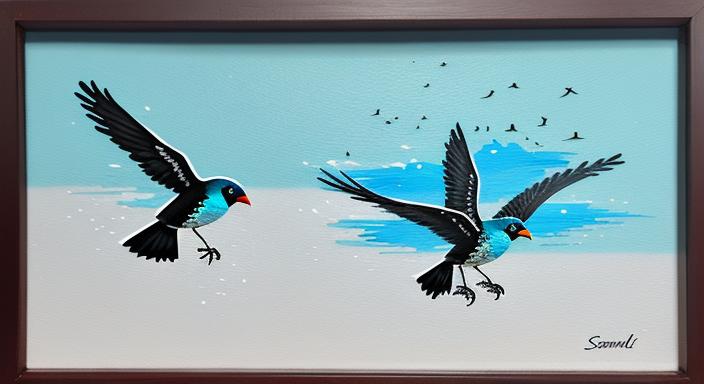
Scrape Art
- Prepare Your Surface: Apply a layer of acrylic paint to your painting surface and allow it to dry.
- Choose a Tool: Select a tool, such as a palette knife or plastic card, for scraping the paint.
- Scrape the Paint: Use the tool to scrape the paint, creating lines, textures, and patterns on the surface.
Drip Painting
- Prepare Your Surface: Apply a layer of acrylic paint to your painting surface and allow it to dry.
- Choose a Tool: Select a tool, such as a pipette or syringe, for dripping the paint.
- Drip the Paint: Hold the tool above the painting surface and allow the paint to drip onto the surface, creating a splatter or drip effect.
Mixed Media Techniques
Mixed media techniques involve combining different materials and mediums, such as acrylics and collage, to create unique and textured artwork. Here’s how to use mixed media techniques:
- Choose Your Materials: Gather various materials, such as fabric, paper, and other textured surfaces, to incorporate into your painting.
- Prepare Your Surface: Apply a layer of acrylic paint to your painting surface and allow it to dry.
- Add Mixed Media Elements: Glue or attach your chosen materials to the painting surface, adding texture and depth to your artwork.
By experimenting with these acrylic painting techniques, you can develop your skills and create unique and expressive paintings that showcase your creativity.
Advanced Acrylic Painting Ideas
As you progress in your acrylic painting journey, you can explore more advanced techniques and subject matter. Here are some ideas to challenge and inspire you:
Detailed Landscapes
Painting detailed landscapes can be a rewarding and challenging endeavor. Focus on capturing the nuances of nature, such as the play of light and shadow, the textures of foliage, and the depth of a scene.
- Seascapes: Paint the crashing waves, rocky coastlines, and serene beaches.
- Cityscapes: Capture the bustling energy of a city, with its towering buildings and intricate architectural details.
- Rural Landscapes: Depict the tranquility of rolling hills, winding roads, and quaint farmhouses.
Portraiture
Painting portraits can be a true test of your skills, as you strive to capture the likeness and essence of your subject. Experiment with different techniques, such as layering and blending, to create realistic and expressive portraits.
- Faces: Focus on the delicate features and expressions of the face.
- Full-Body Portraits: Challenge yourself by painting the entire figure, including clothing and background elements.
- Animal Portraits: Capture the personality and character of your favorite animal subjects.
Mixed Media Techniques
Combining acrylic painting with other media, such as collage, ink, or pastel, can lead to unique and visually striking results. Experiment with different materials and techniques to create one-of-a-kind artworks.
- Acrylic and Collage: Incorporate torn paper, fabric, or other found materials into your acrylic paintings.
- Acrylic and Ink: Use ink to add intricate details, lines, and patterns to your acrylic paintings.
- Acrylic and Pastel: Combine the bold, opaque qualities of acrylic with the soft, blendable nature of pastel.
Glow-in-the-Dark Paintings
Create a mesmerizing and enchanting effect by incorporating glow-in-the-dark paint into your acrylic paintings. This technique is perfect for capturing the magic of night scenes, celestial landscapes, or whimsical fantasy worlds.
- Starry Night Skies: Paint a night sky filled with glowing stars and a crescent moon.
- Bioluminescent Underwater Scenes: Depict the ethereal glow of underwater creatures and plants.
- Glowing Fireflies: Create a captivating scene of fireflies lighting up the darkness.
Painting on Unconventional Surfaces
Expand your creative horizons by painting on surfaces beyond traditional canvas. Experiment with materials like wood, glass, fabric, or even everyday objects to add unique textures and perspectives to your artwork.
- Painted Furniture: Transform a plain piece of furniture, such as a chair or table, into a work of art.
- Painted Shoes or Clothing: Create wearable art by painting on shoes, jackets, or other clothing items.
- Painted Rocks or Stones: Transform ordinary rocks into whimsical, decorative pieces.
By exploring these advanced acrylic painting ideas, you can push the boundaries of your creativity and develop a unique artistic style. Remember to approach each new challenge with an open mind, a willingness to experiment, and a dedication to continuous learning and growth.
Finding Inspiration for Your Acrylic Paintings
Inspiration can come from a variety of sources, and as an acrylic painter, it’s essential to cultivate a mindset that is open to discovering new ideas and subjects. In this section, we’ll explore some ways to find inspiration for your acrylic paintings.
Observe the World Around You
One of the best sources of inspiration is the world around you. Take the time to observe the details and nuances of your everyday surroundings, and consider how you might translate them into an acrylic painting.
- Nature: Pay attention to the colors, textures, and shapes found in plants, landscapes, and natural phenomena.
- Architecture: Explore the lines, patterns, and shadows created by buildings and structures.
- People: Observe the expressions, gestures, and interactions of the people you encounter.
- Still Life: Arrange everyday objects in interesting compositions and use them as the subject of your paintings.
Explore Art History and Contemporary Trends
Studying the work of other artists, both historical and contemporary, can be a rich source of inspiration. Analyze the techniques, styles, and subject matter that captivate you, and consider how you might incorporate them into your acrylic paintings.
- Classic Masterpieces: Examine the work of renowned artists like Vincent van Gogh, Claude Monet, or Georgia O’Keeffe.
- Contemporary Acrylic Painters: Discover the innovative approaches of modern acrylic artists, such as Heather Day, Iris Scott, or Leonid Afremov.
- Art Movements: Explore the visual language and themes of art movements like Impressionism, Expressionism, or Abstract Expressionism.
Acrylic Painters for Inspiration and More Ideas
| Artist | Medium | Notable Works/Style |
|---|---|---|
| Amy Louise Layzell | Acrylic and Watercolor | Landscapes, inspired by travels in Europe |
| Rachael Addis | Acrylic on Canvas | Portraits, figurative art |
| Cherry Watson | Colored Pencils, Pastels, Acrylic | Musician portraits, reimagined classic art |
| Sahara Poette | Acrylic and Watercolor | Semi-abstract flowers, collage landscapes |
| Pamela McMahon | Acrylics | Semi-abstract flowers, collage landscapes |
| Christopher Sanderson-Jones | Pen & Acrylic Wash, Acrylic, Oil | Layered, sculpted faces |
| Holly Rux | Fiber and Acrylic Art | Textured abstract paintings, fiber arts |
| Emily Ward | Acrylic on Canvas | Unique, uplifting art, commissions |
| Heather Day | Acrylic | Abstract, expressive paintings |
| Iris Scott | Acrylic | Textured, impasto-style paintings |
This table highlights a diverse range of acrylic painters, from those who specialize in landscapes and portraits to those who create abstract and mixed-media works. Studying the styles, techniques, and subject matter of these artists could provide valuable inspiration for your acrylic painting journey.
Experiment and Play
Sometimes, the best way to find inspiration is to simply start painting and see where your creativity takes you. Embrace a spirit of experimentation and play, and don’t be afraid to try new techniques or subject matter.
- Freeform Painting: Set aside time for unstructured, intuitive painting sessions, allowing your brush to guide the process.
- Sketchbook Explorations: Use a sketchbook to quickly capture ideas, sketches, and studies that you can later develop into full-scale paintings.
- Collaborative Projects: Engage in creative exchanges with other artists, either in person or online, to inspire and challenge each other.
By drawing inspiration from the world around you, exploring the work of other artists, and embracing a spirit of experimentation, you can unlock a wealth of ideas for your acrylic paintings. Remember, the key is to keep an open mind, stay curious, and trust your creative instincts.
Conclusion
Acrylic painting is a versatile and rewarding medium that offers endless possibilities for artistic expression. Whether you’re a beginner or an experienced artist, the acrylic painting ideas and techniques explored in this article can help you unlock your creativity and create stunning works of art.
From easy landscape and abstract paintings to advanced portraiture and mixed media techniques, the world of acrylic painting is vast and exciting. By embracing the unique properties of acrylics, experimenting with different approaches, and finding inspiration in your surroundings, you can develop a personal style and create paintings that truly reflect your artistic vision.
So, grab your brushes, paints, and palette, and let your creativity soar. The possibilities are as limitless as your imagination. Happy painting!

